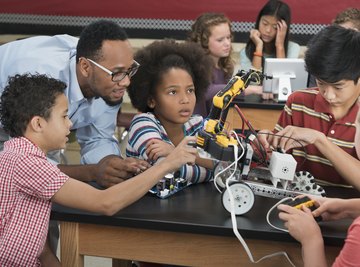
Science fairs are a valuable tool that students can use to place knowledge learned in the classroom into real-life, viewable situations. Numerous science fairs have made use of thousands of studies that have been researched over the years. The ideas have ranged from the commonplace to the bizarre.
The Stroop Experiment
Behavioral science has fascinated the world tremendously since it explains unusual, everyday actions. The Stroop Experiment is a chance to differentiate between automated vs. non-automated behaviors. We all become acclimated to several different behaviors or actions that become habitualized in our daily routines--the Stroop Experiment explains this well.
The experiment dates back to a scientific study done in 1935, in which, being exposed to words spelling out different colors (while being written in an ink of an opposing color), the person in the experiment had trouble pronouncing the color of the ink that the word was written in due to the automated response of the brain reading the text. Taking measurements of success and failure rates will show evidence for this.
The Darkness of the Sky After Sunset
Created by Dr. James Pierce, a professor in astronomy at Minnesota State University, this experiment looks at the differences in twilights during the different portions of the year. By comparing sunset times to specific stars in the sky, different altitudes can be measured, charted and compared--establishing various twilight times. Although not complicated or advanced enough for high school students, this experiment can be lots of fun for smaller children to perform for a science fair.
The Genetic Sequence
A great project for younger children is to focus on the molecular alphabet; namely, that of genomes. By constructing a model and explaining the basic nucleotide sequence of all living things, children can create a project that appreciates the ingenious methods by which nature constructs living creatures.
Adenine and thymine are always paired as well as cytosine and guanine. These nucleotides are made of fundamental building blocks—amino acids. DNA is synthesized to form RNA, which then creates proteins and cells. The level and depth to take the project is normally dependent upon the grade level.
Evolution in Action
A valuable experiment to show evolutionary theory in action is to create a model based upon several changing generations. The experiment revolves around beans and silverware. Although it sounds unusual, these can show evolution in action.
The beans used should be different kinds with different shapes. They should all placed in a general vicinity within a section of grass.
Next, a group of kids are each designated tweezers, spoons, knives or any similar type of accessory. The kids are then given a designated period of time to actively hunt the beans using only their utensil. Anyone that does not get any beans is considered extinct. After each time-period (or generation), the new numbers are recorded and then the experiment is repeated over several generations.
This experiment explains the effect of advantageous mutations from both a predator and prey viewpoint.
The Bouncing Ball
A great, yet simple experiment that goes into explaining energy transfer is as simple as recording a bouncing ball. This experiment appeals to those interested in sports and science alike. When balls are bounced, a transfer of kinetic energy takes place. The ball is deformed and then energy is transferred in specific mannerisms. When balls are filled with different amounts of air, the release of kinetic energy is different due to air molecules. This experiment generally uses an air gauge to test air pressure as well as a measuring equipment to measure heights.
References
About the Author
Steve Johnson is an avid and passionate writer with more than five years of experience. He's written for several industries, including health, dating and Internet marketing, as well as for various websites. He holds a bachelor's degree from the University of Texas.
